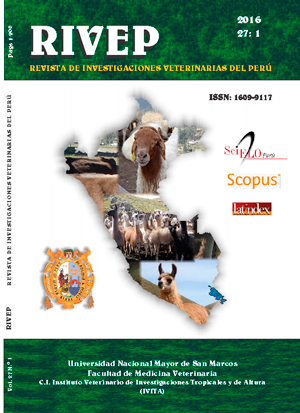Community of helminth parasites of thorny toad Rhinella Spinulosa (Anura: Bufonidae) of Peru
DOI:
https://doi.org/10.15381/rivep.v27i1.11466Keywords:
amphibian, anura, Aplectana, Gorgoderina, helminth, parasite, Peru, RhabdiasAbstract
The aim of this study was to evaluate the community of metazoan parasites of thorny toad Rhinella spinulosa of Peru and elucidate whether sex and the total length of the hosts amphibians are structuring their communities of parasites. Ninety specimens of R. spinulosa were acquired during May 2009 to October 2010. The body cavity, gastrointestinal tract, bladder, lungs and muscles were examined to search for metazoan parasites. Seven taxa of metazoan parasites were collected: one digenean [Gorgoderina chilensis (Gorgoderidae) in the bladder] a cestode [Cylindrotaenia aff. americana (Proteocephalidae) in the small intestine], four nematodes [Aplectana hylambatis and A. vellardi (Cosmocercidae) in the large intestine, Hedruris moniezi (Hedruridae) in the stomach and Rhabdias aff. pseudosphaerocephala (Rhabdiasidae) in lungs] and one acanthocephalan [Pseudoacanthocephalus lutzi (Echinorhynchidae) in the small intestine]. A positive correlation was observed between length and mean abundance of R. aff. pseudosphaerocephala, and an association between sex and mean abundance of G. chilensis, A. hylambatis and R. aff. pseudosphaerocephala. G. chilensis showed dependence on the sex of R. spinulosa. The three levels of aggregation (dispersion index, index discrepancy of Poulin and K negative binomial equation) showed a contagious distribution. Most of the values of alpha diversity of parasitic infracommunities were lower than those of the community component.Downloads
Downloads
Published
Issue
Section
License
Copyright (c) 2016 Jhon Chero, Celso Cruces, José Iannacone, Gloria Sáez, Lorena Alvariño, José Luque, Víctor Morales

This work is licensed under a Creative Commons Attribution-NonCommercial-ShareAlike 4.0 International License.
AUTHORS RETAIN THEIR RIGHTS:
a. Authors retain their trade mark rights and patent, and also on any process or procedure described in the article.
b. Authors retain their right to share, copy, distribute, perform and publicly communicate their article (eg, to place their article in an institutional repository or publish it in a book), with an acknowledgment of its initial publication in the Revista de Investigaciones Veterinarias del Perú (RIVEP).
c. Authors retain theirs right to make a subsequent publication of their work, to use the article or any part thereof (eg a compilation of his papers, lecture notes, thesis, or a book), always indicating the source of publication (the originator of the work, journal, volume, number and date).










